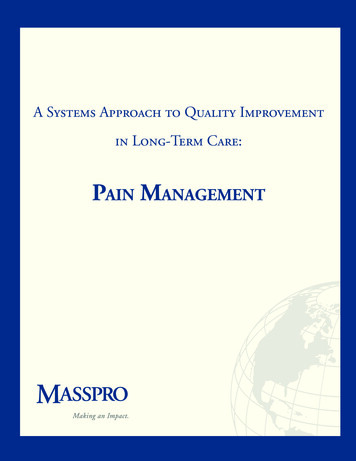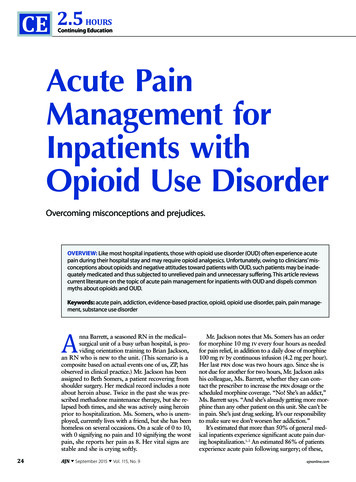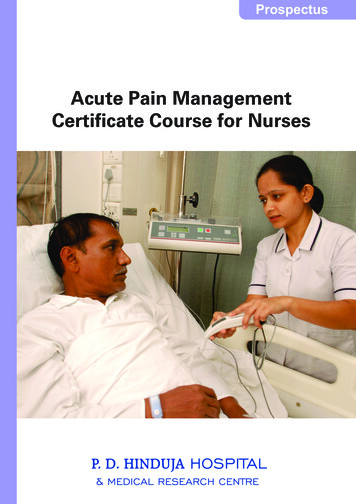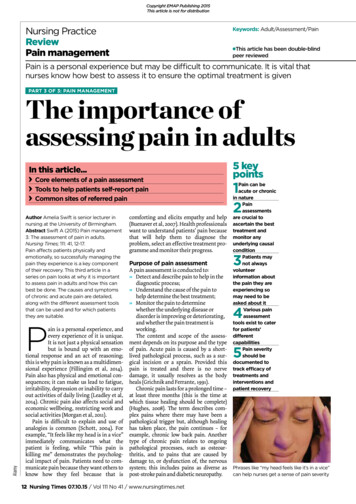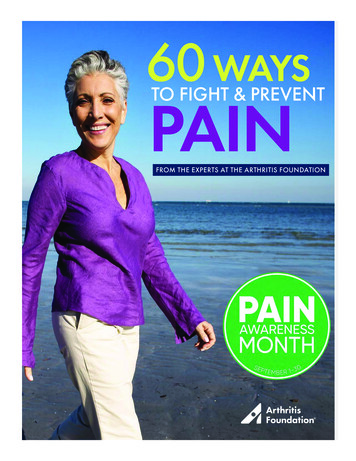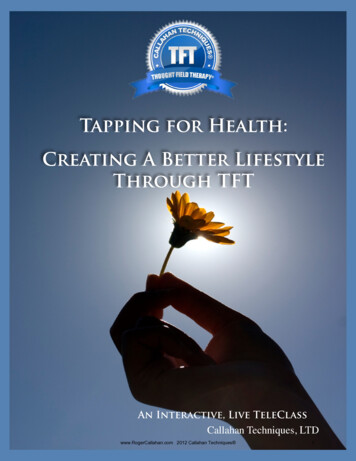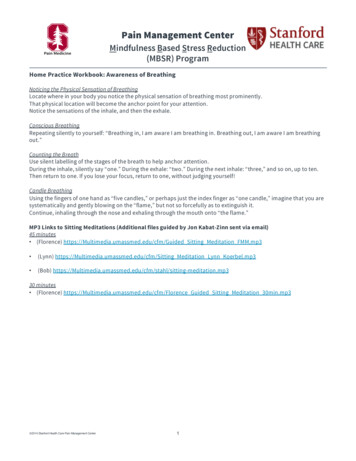
Transcription
Pain Management CenterMindfulness Based Stress Reduction(MBSR) ProgramHome Practice Workbook: Awareness of BreathingNoticing the Physical Sensation of BreathingLocate where in your body you notice the physical sensation of breathing most prominently.That physical location will become the anchor point for your attention.Notice the sensations of the inhale, and then the exhale.Conscious BreathingRepeating silently to yourself: “Breathing in, I am aware I am breathing in. Breathing out, I am aware I am breathingout.”Counting the BreathUse silent labelling of the stages of the breath to help anchor attention.During the inhale, silently say “one.” During the exhale: “two.” During the next inhale: “three,” and so on, up to ten.Then return to one. If you lose your focus, return to one, without judging yourself!Candle BreathingUsing the fingers of one hand as “five candles,” or perhaps just the index finger as “one candle,” imagine that you aresystematically and gently blowing on the “flame,” but not so forcefully as to extinguish it.Continue, inhaling through the nose and exhaling through the mouth onto “the flame.”MP3 Links to Sitting Meditations (Additional files guided by Jon Kabat-Zinn sent via email)45 minutes (Florence) https://Multimedia.umassmed.edu/cfm/Guided Sitting Meditation FMM.mp3 (Lynn) https://Multimedia.umassmed.edu/cfm/Sitting Meditation Lynn Koerbel.mp3 (Bob) meditation.mp330 minutes (Florence) https://Multimedia.umassmed.edu/cfm/Florence Guided Sitting Meditation 30min.mp3 2014 Stanford Health Care Pain Management Center1
Pain Management CenterMindfulness Based Stress Reduction(MBSR) ProgramHome Practice Workbook: Body ScanThe Body Scan is intended to raise awareness of the body by using it as the focus for practicing mindfulness.Simply listen and follow the instructions on the recording.Mindfulness of the body is the primary result of practicing with this scan, though relaxation may also result.Some people use the Body Scan to help them fall asleep, which is fine, but even so, for some of your practice sessionsit would be best to try to remain alert and aware.You will be sent a link to download an MP3 of a guided recording of the Body Scan.My suggestion is that you practice the Body Scan 6 days per week.The benefits you reap from class will correlate with how much time you are able to devote to practice.Some students find practicing first thing in the morning or last thing at night works best for them.Others like to listen to it on the train during commuting, or at lunchtime in their car.Just find a time of day that works best for you and your schedule.MP3 Links to Body Scan Meditations (Additional files guided by Jon Kabat-Zinn sent via email)45 minutes (Florence) https://Multimedia.umassmed.edu/cfm/Guided Body Scan FMM.mp3 (Lynn) https://Multimedia.umassmed.edu/cfm/Body Scan Meditation Lynn Koerbel.mp3 (Bob) n.mp3 (Saki) https://Multimedia.umassmed.edu/cfm/Body Scan Saki Santorelli.mp330 minutes (Florence) https://Multimedia.umassmed.edu/cfm/Florence Body Scan 30 min.mp3 2014 Stanford Health Care Pain Management Center2
Pain Management CenterMindfulness Based Stress Reduction(MBSR) ProgramHome Practice Workbook: Mindful YogaSome people can be reluctant to exercise because it involves discomfort or strain, or requires specialequipment or others to work out with, or going to a special place to do it. If this has been the case for you,then hatha yoga might be a helpful practice.The word “yoga”, means “yoke” in Sanskrit. It implies a harnessing together and a unifying of body andmind. Yoga can be a form of meditation, and when done regularly, is an excellent mind/body discipline forpeople who wish to move towards greater levels of health.Hatha yoga consists of postures done mindfully and with awareness of breathing. They are fairly simple andcan have dramatic effects if practiced regularly. The poses we are doing are extremely gentle. Regularpractice will increase your flexibility, strength and balance, as well as help you enter a state of deeprelaxation and awareness. Many people experience a greater serenity about life in general, improvedcirculation, a firmer, trimmer figure, and less illness as a result.In practicing yoga, you are advised to practice in the same way that you do when meditating, namelymaintaining moment to moment awareness, and not striving to get somewhere. Just allowing yourself tobe as you are, and letting go of any judging of yourself. Move slowly and consciously. Mindful yoga involvesexploring your limits, but not pushing beyond them. Instead, you play with dwelling at the boundary andbreathe. This requires honoring your body and the messages it gives you about when to stop and when toavoid doing a posture because of your particular circumstances.Yoga requires no special equipment and can be done almost anywhere. You can learn it from the MBSRrecordings. If you find you are drawn to yoga, you get ideas for new postures by taking yoga classes. It’sgreat to experiment mindfully.MP3 Links to Standing and Lying Yoga45 minutes - Standing (Florence) https://Multimedia.umassmed.edu/cfm/Guided Standing Yoga FMM.mp3 (Lynn) https://Multimedia.umassmed.edu/cfm/Standing Yoga Lynn Koerbel.mp3 (Bob) -yoga.mp345 minutes – Sitting and Lying (Florence) https://Multimedia.umassmed.edu/cfm/Guided Sitting Yoga FMM.mp3 (Lynn) https://Multimedia.umassmed.edu/cfm/Lying Down Yoga Lynn Koerbel.mp3 (Bob) ga.mp330 minutes – Standing and Lying (Florence) https://Multimedia.umassmed.edu/cfm/Florence Standing Yoga 30 min.mp3 (Florence) https://Multimedia.umassmed.edu/cfm/Florence Lying Yoga 30 min.mp3 2014 Stanford Health Care Pain Management Center3
Pain Management CenterMindfulness Based Stress Reduction(MBSR) ProgramHome Practice Workbook: Standing Yoga Postures 2014 Stanford Health Care Pain Management Center4
Pain Management CenterMindfulness Based Stress Reduction(MBSR) ProgramHome Practice Workbook: Standing Yoga Postures 2014 Stanford Health Care Pain Management Center5
Pain Management CenterMindfulness Based Stress Reduction(MBSR) ProgramHome Practice Workbook: Standing Yoga Postures 2014 Stanford Health Care Pain Management Center6
Pain Management CenterMindfulness Based Stress Reduction(MBSR) ProgramHome Practice Workbook: Standing Yoga Postures 2014 Stanford Health Care Pain Management Center7
Pain Management CenterMindfulness Based Stress Reduction(MBSR) ProgramHome Practice Workbook: Lying Yoga Postures 2014 Stanford Health Care Pain Management Center8
Pain Management CenterMindfulness Based Stress Reduction(MBSR) ProgramHome Practice Workbook: Lying Yoga Postures continued 2014 Stanford Health Care Pain Management Center9
Pain Management CenterMindfulness Based Stress Reduction(MBSR) ProgramHome Practice Workbook: Lying Yoga Postures continued 2014 Stanford Health Care Pain Management Center10
Pain Management CenterMindfulness Based Stress Reduction(MBSR) ProgramHome Practice Workbook: Lying Yoga Postures continued 2014 Stanford Health Care Pain Management Center11
Yoga can be a form of meditation, and when done regularly, is an excellent mind/body discipline for people who wish to move towards greater levels of health. Hatha yoga consists of


